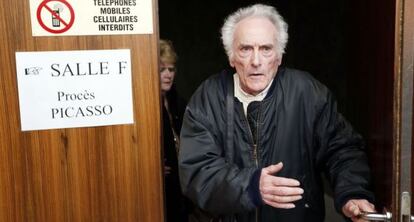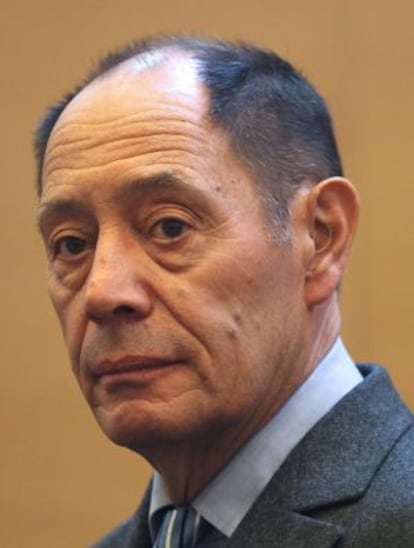The electrician with 271 Picassos
Artist’s ex-employee goes on trial over €60 million art stash he claims he received as gift

It was Pierre Le Guennec who first got in touch with the Picasso Administration to certify the authenticity of some drawings. The year was 2010.
After a couple of letter exchanges, the retired electrician showed up at the offices of the Málaga-born painter’s son, Claude Picasso, with a trolley bag. To the amazement of everyone in the room, Le Guennec pulled out what was to become the largest Picasso discovery since the artist’s death in 1973: 180 individual artworks and a notebook containing 91 sketches.
Le Guennec, 75, was Picasso’s electrician during his latter years, and he claims that the artist’s widow gave him the extraordinary treasure trove, which has been valued at over €60 million.
Monsieur and Madame trusted me, they always called me ‘little cousin’” Pierre Le Guennec
But Picasso’s heirs felt it unlikely that their father or his wife would make such a donation, and instead filed a criminal complaint against Le Guennec and his wife Danielle, 71, for possession of stolen goods.
Five years after the astonishing find, the trial began on Tuesday inside a court in Grasse, in southeastern France.
The hearing began with testimony from both defendants, who face a five-year prison sentence and a fine of €375,000. On Wednesday and Thursday the court will hear from the plaintiffs, who include the artist’s children, Claude and Maya Picasso, and Catherine Hutin-Blay, daughter of Picasso’s widow, Jacqueline Roque.
The 271 artworks were made between 1900 and 1932, a key period in the artist’s career, and they include nine Cubist collages, six small oils, 28 lithographs and drawings of his muses Olga and Fernande.
“There are extremely important works that were missing from the narrative of art history and that highlight very important moments,” said Claude Picasso, who is in charge of his father’s legacy, at the beginning of the trial.

“It is early to say what’s going to happen, but it is clear that all art historians will be interested in being able to see them, possibly in a museum,” he added.
Le Guennec, for his part, announced that if he wins the case he will place the drawings on public display instead of selling them.
The defendant told judge Catherine Bonnici that Jacqueline Roque, Picasso’s last wife, handed him a box one day – possibly in 1971, although he could not recollect the date with certainty – and said “Here, this is for you.”
Le Guennec, who worked at Picasso’s Villa Notre-Dame de Vie in Mougins (near Grasse) from 1970 to 1973, says he did not place too much value on the gift.
“I opened up a box full of ripped drawings, I didn’t even look at it all,” he said. “We don’t have paintings, this is a sentimental gift.”
For nearly four decades, the valuable art stash remained stored away inside the garage of the modest house where the Le Guennecs live, in the Alpes Maritimes department. Sat on a shelf, it wasn’t opened again until 2009.
Le Guennec, who is seriously ill, explained that he wanted to identify all of his possessions with a view to his own children’s legacy. That is why he voluntarily got in touch with the Picasso Administration in all good faith. He even got his brother, a gallery owner who has since passed away, to help him draw up an inventory of the work, he told the court.
The defense is trying to prove that the electrician was more than just a mere employee, and was close to the Picassos. “Monsieur and Madame trusted me, they always called me ‘little cousin,’” said Le Guennec.
Le Guennec continued to work for Picasso’s widow until she committed suicide in 1986, he said. Jacqueline even loaned him 540,000 francs (around €140,000) so he could purchase a taxi license in 1983. Although the loan provides evidence of the good relationship between both, the prosecution wondered why the electrician asked Jacqueline for money when she had allegedly already given him a much more valuable gift.
Picasso’s heirs also note that the drawings are not signed, which was rare for the artist. “It is not possible. He would sign Picasso, and add the date and the place, to prevent future mixups,” said Maya Picasso in statements to radio station France Info. “Above all, my father never gave away portraits of his children and lovers.”
A few months into the investigation, the discovery of the electrician’s ties with another Picasso employee suspected of stealing nearly 200 artworks added a new twist to the tale. Maurice Bresnus, better known as Nounours (Teddy Bear) and married to Le Guennec’s first cousin, was the painter’s chauffeur between 1967 and 1973. It was he who recommended the electrician when Picasso began looking for one.
We are dealing with an international art-laundering operation”
Claude Picasso's lawyer
In the event, French justice has only decided to try the Le Guennecs for possessing stolen goods, leaving aside the question of who stole them in the first place.
“It is of little importance that the author of the crime has not been identified,” wrote the judge in her brief. “Pierre and Danielle Le Guennec were aware of their fraudulent origin.”
In court, Claude Picasso’s lawyer, Jean-Jacques Neuer, went much further in his accusations: “We are faced with an international art-laundering operation. The artworks were handed to him because he had a relationship with Picasso.”
Tu suscripción se está usando en otro dispositivo
¿Quieres añadir otro usuario a tu suscripción?
Si continúas leyendo en este dispositivo, no se podrá leer en el otro.
FlechaTu suscripción se está usando en otro dispositivo y solo puedes acceder a EL PAÍS desde un dispositivo a la vez.
Si quieres compartir tu cuenta, cambia tu suscripción a la modalidad Premium, así podrás añadir otro usuario. Cada uno accederá con su propia cuenta de email, lo que os permitirá personalizar vuestra experiencia en EL PAÍS.
¿Tienes una suscripción de empresa? Accede aquí para contratar más cuentas.
En el caso de no saber quién está usando tu cuenta, te recomendamos cambiar tu contraseña aquí.
Si decides continuar compartiendo tu cuenta, este mensaje se mostrará en tu dispositivo y en el de la otra persona que está usando tu cuenta de forma indefinida, afectando a tu experiencia de lectura. Puedes consultar aquí los términos y condiciones de la suscripción digital.
Últimas noticias
Most viewed
- Pablo Escobar’s hippos: A serious environmental problem, 40 years on
- Reinhard Genzel, Nobel laureate in physics: ‘One-minute videos will never give you the truth’
- Why we lost the habit of sleeping in two segments and how that changed our sense of time
- Charles Dubouloz, mountaineering star, retires at 36 with a farewell tour inspired by Walter Bonatti
- The Florida Keys tourist paradise is besieged by immigration agents: ‘We’ve never seen anything like this’








































